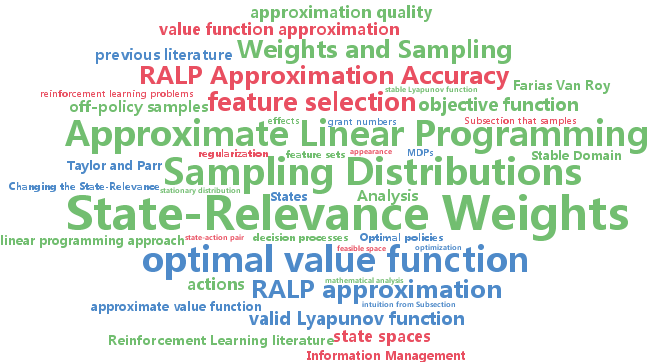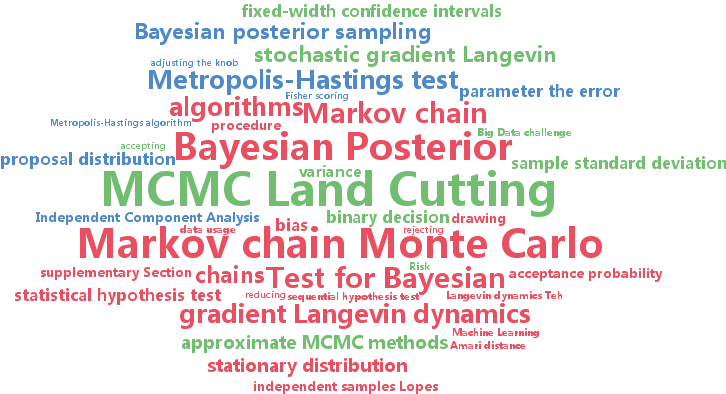stationary distribution
-
Alan Malek and Yasin Abbasi-Yadkori and Peter Bartlett
Linear Programming for Large-Scale Markov Decision Problems (pdf)
We consider the problem of controlling a Markov decision process (MDP) with a large state space, so as to minimize average cost. Since it is intractable to compete with the optimal policy for large scale problems, we pursue the more modest goal of competing with a low-dimensional family of policies. We use the dual linear programming formulation of the MDP average cost problem, in which the variable is a stationary distribution over state-action pairs, and we consider a neighborhood of a low-dimensional subset of the set of stationary distributions (defined in terms of state-action features) as the comparison class. We propose two techniques, one based on stochastic convex optimization, and one based on constraint sampling. In both cases, we give bounds that show that the performance of our algorithms approaches the best achievable by any policy in the comparison class. Most importantly, these results depend on the size of the comparison class, but not on the size of the state space. Preliminary experiments show the effectiveness of the proposed algorithms in a queuing application.
-
Christopher Tosh and Sanjoy Dasgupta
Lower Bounds for the Gibbs Sampler over Mixtures of Gaussians (pdf)
The mixing time of a Markov chain is the minimum time $t$ necessary for the total variation distance between the distribution of the Markov chain's current state $X_t$ and its stationary distribution to fall below some $\epsilon > 0$. In this paper, we present lower bounds for the mixing time of the Gibbs sampler over Gaussian mixture models with Dirichlet priors.
-
Yoshua Bengio and Eric Laufer and Guillaume Alain and Jason Yosinski
Deep Generative Stochastic Networks Trainable by Backprop (pdf)
We introduce a novel training principle for probabilistic models that is an alternative to maximum likelihood. The proposed Generative Stochastic Networks (GSN) framework is based on learning the transition operator of a Markov chain whose stationary distribution estimates the data distribution. Because the transition distribution is a conditional distribution generally involving a small move, it has fewer dominant modes, being unimodal in the limit of small moves. Thus, it is easier to learn, more like learning to perform supervised function approximation, with gradients that can be obtained by backprop. The theorems provided here generalize recent work on the probabilistic interpretation of denoising autoencoders and provide an interesting justification for dependency networks and generalized pseudolikelihood (along with defining an appropriate joint distribution and sampling mechanism, even when the conditionals are not consistent). GSNs can be used with missing inputs and can be used to sample subsets of variables given the rest. Successful experiments are conducted, validating these theoretical results, on two image datasets and with a particular architecture that mimics the Deep Boltzmann Machine Gibbs sampler but allows training to proceed with backprop, without the need for layerwise pretraining.
-
Tianqi Chen and Emily Fox and Carlos Guestrin
Stochastic Gradient Hamiltonian Monte Carlo (pdf)
Hamiltonian Monte Carlo (HMC) sampling methods provide a mechanism for defining distant proposals with high acceptance probabilities in a Metropolis-Hastings framework, enabling more efficient exploration of the state space than standard random-walk proposals. The popularity of such methods has grown significantly in recent years. However, a limitation of HMC methods is the required gradient computation for simulation of the Hamiltonian dynamical system-such computation is infeasible in problems involving a large sample size or streaming data. Instead, we must rely on a noisy gradient estimate computed from a subset of the data. In this paper, we explore the properties of such a stochastic gradient HMC approach. Surprisingly, the natural implementation of the stochastic approximation can be arbitrarily bad. To address this problem we introduce a variant that uses second-order Langevin dynamics with a friction term that counteracts the effects of the noisy gradient, maintaining the desired target distribution as the invariant distribution. Results on simulated data validate our theory. We also provide an application of our methods to a classification task using neural networks and to online Bayesian matrix factorization.
-
Gavin Taylor and Connor Geer and David Piekut
An Analysis of State-Relevance Weights and Sampling Distributions on L1-Regularized Approximate Linear Programming Approximation Accuracy (pdf)
Recent interest in the use of $L_1$ regularization in the use of value function approximation includes Petrik et al.'s introduction of $L_1$-Regularized Approximate Linear Programming (RALP). RALP is unique among $L_1$-regularized approaches in that it approximates the optimal value function using off-policy samples. Additionally, it produces policies which outperform those of previous methods, such as LSPI. RALP's value function approximation quality is affected heavily by the choice of state-relevance weights in the objective function of the linear program, and by the distribution from which samples are drawn; however, there has been no discussion of these considerations in the previous literature. In this paper, we discuss and explain the effects of choices in the state-relevance weights and sampling distribution on approximation quality, using both theoretical and experimental illustrations. The results provide insight not only onto these effects, but also provide intuition into the types of MDPs which are especially well suited for approximation with RALP.
-
Anoop Korattikara and Yutian Chen and Max Welling
Austerity in MCMC Land: Cutting the Metropolis-Hastings Budget (pdf)
Can we make Bayesian posterior MCMC sampling more efficient when faced with very large datasets? We argue that computing the likelihood for N datapoints in the Metropolis-Hastings (MH) test to reach a single binary decision is computationally inefficient. We introduce an approximate MH rule based on a sequential hypothesis test that allows us to accept or reject samples with high confidence using only a fraction of the data required for the exact MH rule. While this method introduces an asymptotic bias, we show that this bias can be controlled and is more than offset by a decrease in variance due to our ability to draw more samples per unit of time.





